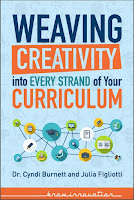by Julia Figliotti
 What is creativity? How can you foster it in your classroom?
And how can you incorporate it into your lessons without falling behind on your
curriculum plans? As teachers, these are questions that you might face every
day – and today, we have answers.
What is creativity? How can you foster it in your classroom?
And how can you incorporate it into your lessons without falling behind on your
curriculum plans? As teachers, these are questions that you might face every
day – and today, we have answers.
Creativity is a key skill for your students, both within the
classroom and outside of it, so we interviewed more than 100 teachers and
creativity experts from around the world to gather their favorite techniques
for bringing creative thinking skills into any curriculum. Out of 750 tips and
ideas, here are our ten favorites to help you deliberately weave various
creative thinking skills into every one of your lessons and bring creativity into your classroom!
Ten Ways to Weave Creativity into Your Curriculum
When students ask questions, don’t rush to give them “the answer.” First ask, “What do you think?” Often we focus on providing answers, but allowing students to think about their own questions can be very powerful. (Skill: Curiosity)
Talk about engaging! By encouraging your students to explore the possibilities on their own, you are both opening their minds to a whole world of potential, and empowering their imaginations.
Challenge students to use sketches or Mind Maps to illustrate problems, processes, and/or understandings of a topic. (Skill: Embrace the Challenge)
In order to completely accept a challenge, your students must first understand it. With Mind Maps, you will be encouraging your students to explore every aspect of the challenge at hand before diving into finding a solution.
Stop reading a story at the climax and list all the possible conclusions. (Skill: Produce and Consider Many Alternatives)
This exercise is a lot of fun – it engages the class and allows for some wild and crazy ideas to come forward. Who knows? It may even lead a few of your students down the path of writing!
Watch old Science Fiction videos and TV shows in class and see what has actually been invented. (Skill: Enjoy and Use Fantasy)
This is a great activity! Your students will love the old-time special effects, marvel at the predictions that came to be, and maybe even make a few futuristic predictions of their own!
Have students play PowerPoint karaoke. You control the slides as they present the material, and they don’t know what’s coming next. (Skill: Tolerate the Ambiguity)
This one can be a little stressful, so it’s important to keep a light-hearted environment. Students will be teaching others the content, and themselves! For extra fun, ask them to present in character (as a boring professor, as Miss Frizzle, etc.)!
Have students write a Tweet (140 characters or less) to highlight what they have learned. (Skill: Highlight the Essence)
Finally, students can put all of their tweeting to good use! And if they use less than 140 characters to reflect on a lesson, encourage the use of hashtags. #becausewedonthaveenoughofthosealready
Switch theoretical perspectives – have students defend a point of view that they don’t agree with, and see how their perspectives change. (Skill: Look at it Another Way)
This exercise is interesting to participate in, and even more interesting to watch. At first, your students will end up arguing against their assigned perspectives, but with gentle reminders, they may even convince themselves that this new point of view is the way to go!
Introduce students to songs that match up with your lesson (“Oliver Cromwell,” “We Didn’t Start the Fire,” the Quadratic Formula song, etc.). (Skill: Make it Swing! Make it Ring!)
Music makes everything more memorable! Most people know all of the words to at least one song – whether they understand what they mean or not. By applying lyrics to your lesson, students will have an easier time remembering the details.
Introduce the Nine Dots puzzle (Skill: Break Through and Extend the Boundaries)
This quintessential “think outside the box” puzzle will have your students stumped – until you give them a little hint and introduce new possibilities!
Literally keep things open (i.e. windows, doors, books) to see what other things come in (i.e. leaves, wind, people, dust). Use this as a metaphor for open minds and ideas. (Skill: Keep Open)
Who would’ve thought that such a simple parallel could have such a strong message behind it? This exercise can be brought back as the perfect reminder to defer judgment and not reject – or accept – ideas too quickly.
About the Book
Weaving Creativity
into Every Strand of Your Curriculum is an educational must-have, written
by Dr. Cyndi Burnett and Julia Figliotti. It incorporates the input of
creativity professionals and educators worldwide to bring you the best ways to
bring creativity into your lesson plans. From kindergarten through college, it is
the go-to book for a more creative classroom environment! Buy it here:
Kindle: http://tinyurl.com/weaving-kindle
(FREE through June 19!)
Black & White: http://tinyurl.com/weaving-bw

1 comment:
Love the ideas here... I'm going to have to try the "pause the story" one some time.
Powerpoint Karaoke is great too... we used to play it at my last company (works great for adults too).
Post a Comment